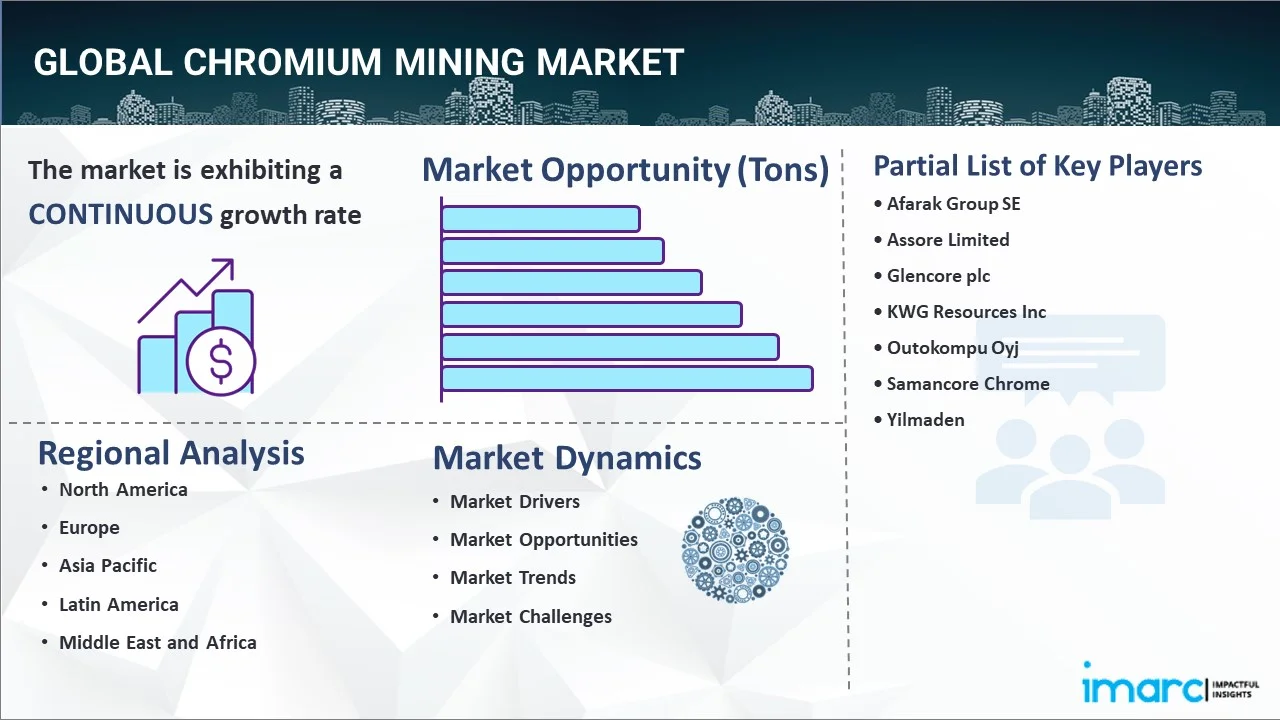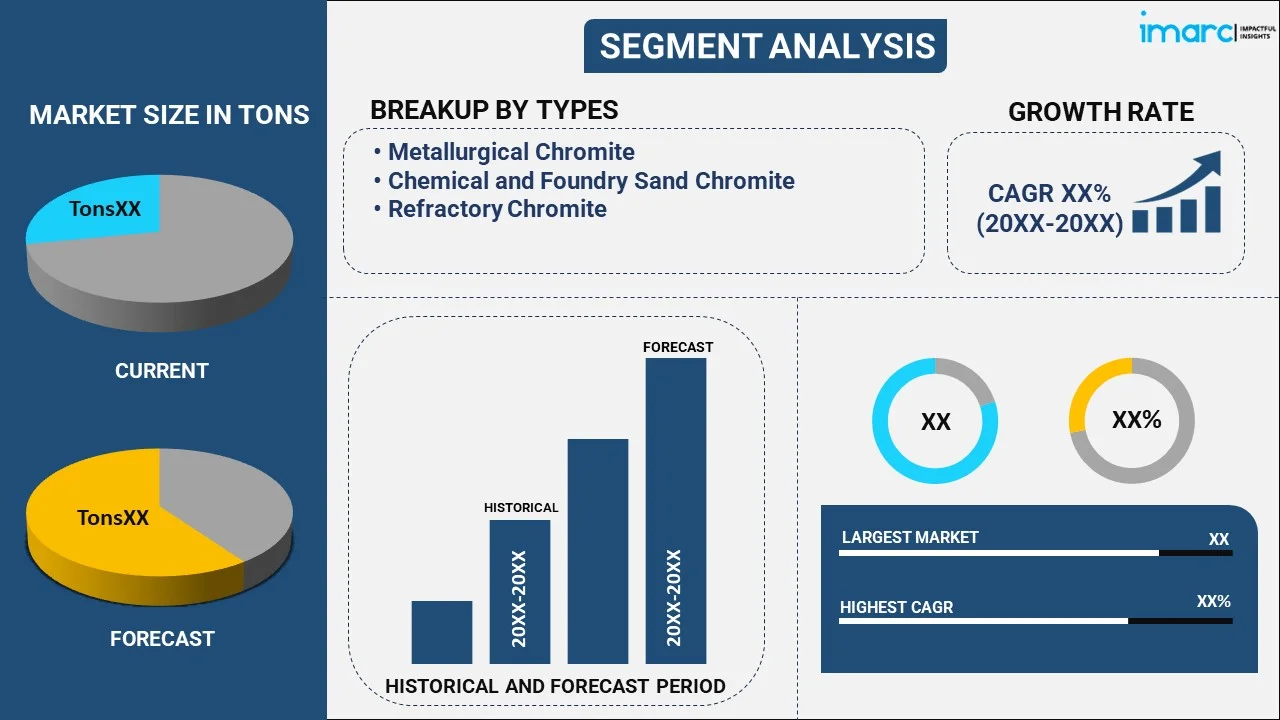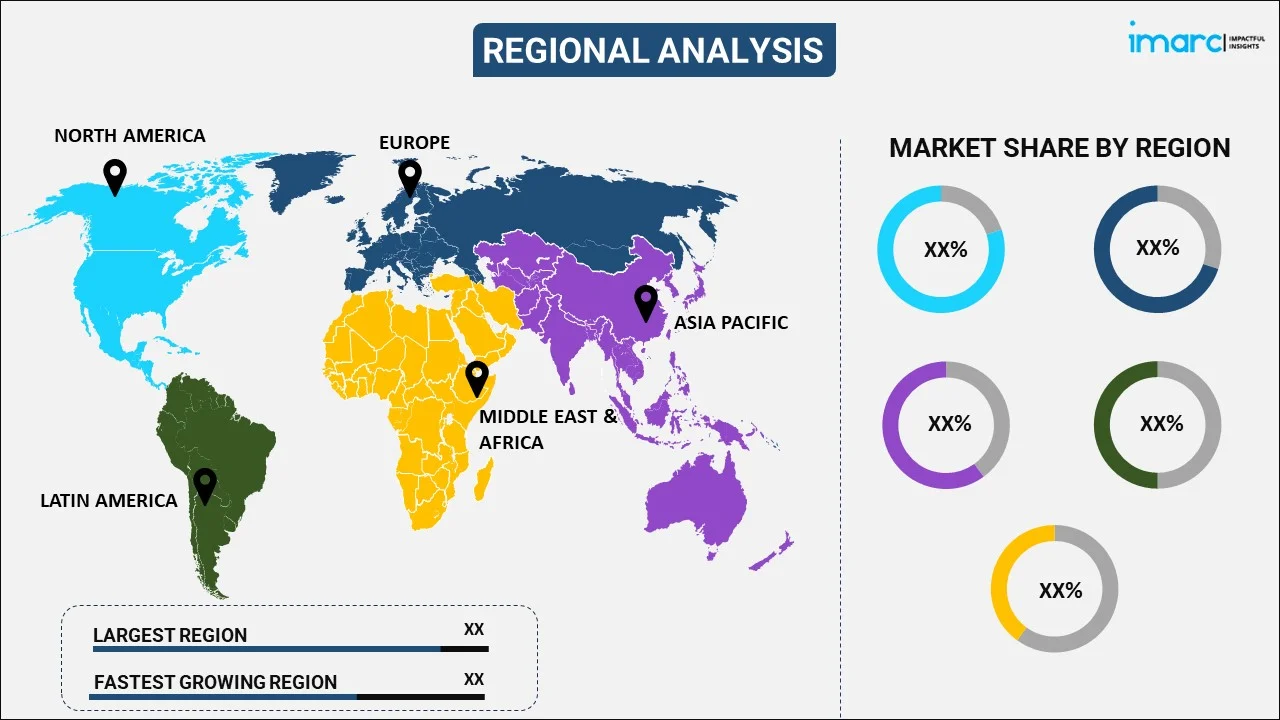
Chromium Mining Market Report by Type (Metallurgical Chromite, Chemical and Foundry Sand Chromite, Refractory Chromite), End User (Stainless Steel, Alloy Steel), and Region 2025-2033
Market Overview:
The global chromium mining market size reached 45.7 Million Tons in 2024. Looking forward, IMARC Group expects the market to reach 63.6 Million Tons by 2033, exhibiting a growth rate (CAGR) of 3.57% during 2025-2033. The expansion in the metallurgy industry, extensive research and development (R&D) activities and increasing government investment represent some of the key factors driving the market.
|
Report Attribute
|
Key Statistics
|
|---|---|
|
Base Year
|
2024
|
|
Forecast Years
|
2025-2033
|
|
Historical Years
|
2019-2024
|
|
Market Size in 2024
|
45.7 Million Tons |
|
Market Forecast in 2033
|
63.6 Million Tons |
| Market Growth Rate 2025-2033 | 3.57% |
Chromium is a lustrous, hard, bluish-gray metal found naturally in rocks, animals, plants, soil, volcanic dust, and gasses. It is chiefly obtained from the mineral chromite that is carried out by surface techniques and underground mining processes. Surface techniques are usually used first to mine chromite ore. The method includes an open pit, from which the non-chromite-bearing surface materials and chromite ores are generally extracted. On the other hand, blasthole stoping techniques are commonly utilized for carrying out underground mining. Chromium is widely used to harden steel, make alloys, manufacture stainless steel, dyes, and pigments, treat cool tower water, and preserve leather and wood. It also exhibits durability, strength, toughness, corrosion, and chemical resistance to iron-steel products.

Chromium Mining Market Trends:
The increasing demand for chromium in the metallurgy industry across the globe is one of the key factors driving the market growth. The chromium mining process is widely used due to the rising demand for chromium for the production of metals, such as steel and aluminum. In line with this, the widespread process utilization for producing stainless steel, which is widely utilized in the manufacturing of cutlery, surgical tools, car exhaust systems, seatbelts, and kitchen sinks, is favoring the market growth. Additionally, the utilization of chromium for producing piston rings, shock absorbers, engine valves, and brake pistons in the automotive industry is acting as another major growth-inducing factor. Apart from this, the introduction of chromite smelting technology that requires low capital investment and offers flexibility is providing an impetus to the market growth. Moreover, the increasing chromium mining activities to obtain pigments of chromium that are widely used in paints as inhibitors for recirculating water systems, brines, and dips for brass, tin, steel, and iron, is positively influencing the market growth. Furthermore, the widespread adoption of chromium in the medical industry owing to the rising geriatric population prone to chronic diseases and serious health conditions is driving the market growth. Chromium is widely used for manufacturing medicines essential in regulating blood sugar levels, which is propelling the market growth. Other factors, including rising production of metals, extensive research and development (R&D) activities and increasing government investment in the metal and mining industry, are anticipated to drive the market growth.
Key Market Segmentation:
IMARC Group provides an analysis of the key trends in each segment of the global chromium mining market, along with forecasts at the global, regional, and country level from 2025-2033. Our report has categorized the market based on the type and end user.
Type Insights:

- Metallurgical Chromite
- Chemical and Foundry Sand Chromite
- Refractory Chromite
The report has provided a detailed breakup and analysis of the chromium mining market based on the type. This includes metallurgical, chemical, and foundry sand and refractory chromite. According to the report, metallurgical chromite represented the largest segment.
End User Insights:
- Stainless Steel
- Alloy Steel
The report has provided a detailed breakup and analysis of the chromium mining market based on the end user. This includes stainless and alloy steel. According to the report, stainless steel represented the largest segment.
Regional Insights:

- North America
- United States
- Canada
- Asia Pacific
- China
- Japan
- India
- South Korea
- Australia
- Indonesia
- Others
- Europe
- Germany
- France
- United Kingdom
- Italy
- Spain
- Russia
- Others
- Latin America
- Brazil
- Mexico
- Others
- Middle East and Africa
The report has also provided a comprehensive analysis of all the major regional markets that include North America (the United States and Canada); Europe (Germany, France, the United Kingdom, Italy, Spain, Russia, and others); Asia Pacific (China, Japan, India, South Korea, Australia, Indonesia, and others); Latin America (Brazil, Mexico, and others); and the Middle East and Africa. According to the report, Asia Pacific was the largest market for chromium mining. Some of the factors driving the Asia Pacific chromium mining market included widespread process utilization for producing stainless steel, significant technological advancements, and extensive research and development (R&D) activities.
Competitive Landscape:
The report has also provided a comprehensive analysis of the competitive landscape in the global chromium mining market. Detailed profiles of all major companies have also been provided. Some of the companies covered include Afarak Group SE, Assore Limited, Glencore plc, KWG Resources Inc, Outokompu Oyj, Samancore Chrome, Yilmaden, etc. Kindly note that this only represents a partial list of companies, and the complete list has been provided in the report.
Report Coverage:
| Report Features | Details |
|---|---|
| Base Year of the Analysis | 2024 |
| Historical Period | 2019-2024 |
| Forecast Period | 2025-2033 |
| Units | Million USD, Million Tons |
| Types Covered | Metallurgical Chromite, Chemical and Foundry Sand Chromite, Refractory Chromite |
| End Users Covered | Stainless Steel, Alloy Steel |
| Regions Covered | Asia Pacific, Europe, North America, Latin America, Middle East and Africa |
| Countries Covered | United States, Canada, Germany, France, United Kingdom, Italy, Spain, Russia, China, Japan, India, South Korea, Australia, Indonesia, Brazil, Mexico |
| Companies Covered | Afarak Group SE, Assore Limited, Glencore plc, KWG Resources Inc, Outokompu Oyj, Samancore Chrome, Yilmaden, etc. |
| Customization Scope | 10% Free Customization |
| Post-Sale Analyst Support | 10-12 Weeks |
| Delivery Format | PDF and Excel through Email (We can also provide the editable version of the report in PPT/Word format on special request) |
Key Questions Answered in This Report:
- How has the global chromium mining market performed so far and how will it perform in the coming years?
- What are the drivers, restraints, and opportunities in the global chromium mining market?
- What are the key regional markets?
- Which countries represent the most attractive chromium mining markets?
- What is the breakup of the market based on the type?
- What is the breakup of the market based on the end user?
- What is the competitive structure of the global chromium mining market?
- Who are the key players/companies in the global chromium mining market?
Key Benefits for Stakeholders:
- IMARC’s report offers a comprehensive quantitative analysis of various market segments, historical and current market trends, market forecasts, and dynamics of the chromium mining market from 2019-2033.
- The research study provides the latest information on the market drivers, challenges, and opportunities in the global chromium mining market.
- The study maps the leading as well as the fastest growing regional markets. It further enables stakeholders to identify the key country-level markets within each region.
- Porter's five forces analysis assist stakeholders in assessing the impact of new entrants, competitive rivalry, supplier power, buyer power, and the threat of substitution. It helps stakeholders to analyze the level of competition within the chromium mining industry and its attractiveness.
- Competitive landscape allows stakeholders to understand their competitive environment and provides an insight into the current positions of key players in the market.
Need more help?
- Speak to our experienced analysts for insights on the current market scenarios.
- Include additional segments and countries to customize the report as per your requirement.
- Gain an unparalleled competitive advantage in your domain by understanding how to utilize the report and positively impacting your operations and revenue.
- For further assistance, please connect with our analysts.
 Inquire Before Buying
Inquire Before Buying
 Speak to an Analyst
Speak to an Analyst
 Request Brochure
Request Brochure
 Request Customization
Request Customization




.webp)




.webp)












